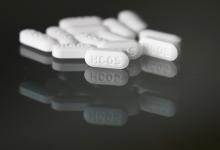FDA Approves Cosentyx for Ankylosing Spondylitis and Psoriatic Arthritis Save

Cosentyx (secukinumab) was approved by the FDA on 15 January, 2016 for patients with active ankyosing spondylitis (AS) and psoriatic arthritis (PsA). Secukinumab was approved in the European Union last year for both AS and PsA. Until now, this agent was FDA-approved for moderate to severe plaque psoriasis only.
These two new approvals are based on the FUTURE 1 & 2 and MEASURE 1 & 2 trials involving over 1500 patients in Phase III clinical trials. It is estimated that more than 9,600 patients have been treated with secukinumab in clinical trials across multiple indications, and over 15,000 patients with psoriasis have already been treated in the post-marketing setting.
Secukinumab is a fully human monoclonal antibody against IL-17, and is the first of several IL-17 targeted therapies to come to market.
Phase III studies included more than 1,500 adult patients with AS or PsA that were biologic-treatment naïve or had an inadequate response/were intolerant to anti-TNF therapy. Cosentyx hit its key targets by achieving statistically significant improvements versus placebo in the signs and symptoms of both conditions, as measured by at least a 20% improvement in the Assessment of Spondyloarthritis International Society criteria at Week 16, and a 20% reduction in the American College of Rheumatology (ACR 20) response criteria at Week 24, respectively.
Prescribing details can be found here. For psoriatic arthritis, the drug can be given with or without a subcutaneous (SC) loading dose. With a loading dose, secukinumab is given 150 mg SC at weeks 0, 1, 2, 3, and 4 and then subcutaneously every 4 weeks thereafter. Without a loading dose, the drug is given as 150 mg every 4 weeks SC. For those who continue to have activie PsA with the lower dose, an increased dose of 300 mg SC every 4 weeks can be used (by comparison, the dose used for psoriasis is 300 mg SC at Weeks 0, 1,2, 3, and 4 followed by 300 mg every 4 weeks and the dose can be lowered to 150 mg if need be). Ankylosing spondylitis dosing is the same, except there is no provision to increase to 300 mg SC.
The warnings and precautions predictably included infections, tuberculosis, inflammatory bowel disease (new onset or exacerbation) and hypersensitivity reactions. The infection risk is comparatively low, with serious infectious events occuring in 0.14% on secukinumab and in 0.3% of patients treated with placebo in the psoriasis trials. There is a recommendation for TB screening, but the actual risk of TB and TB reactivation is very low (compared to TNF inhibitors). Lastly, the risk for candidiasis appears to be low with mucocutaneous candida infections occuring in 1.2% of secukinumab patients (versus 0.3% on placebo). No cases of systemic candidiasis have been reported.
The drug comes as a 150 mg prefilled syringe, Sensoready pen or 150 mg vials of lyophylized powder for reconstitution and IV administration.










If you are a health practitioner, you may Login/Register to comment.
Due to the nature of these comment forums, only health practitioners are allowed to comment at this time.